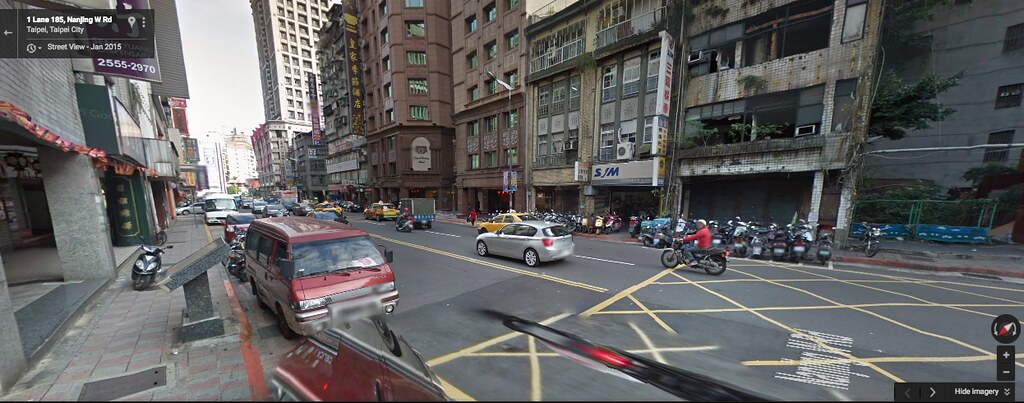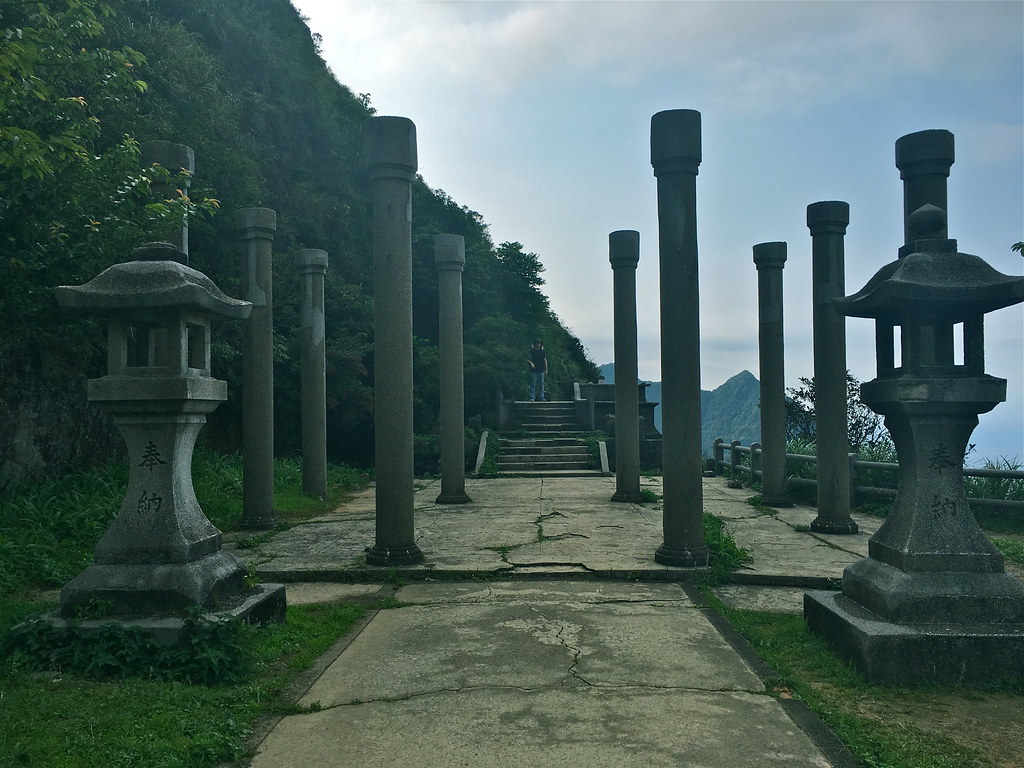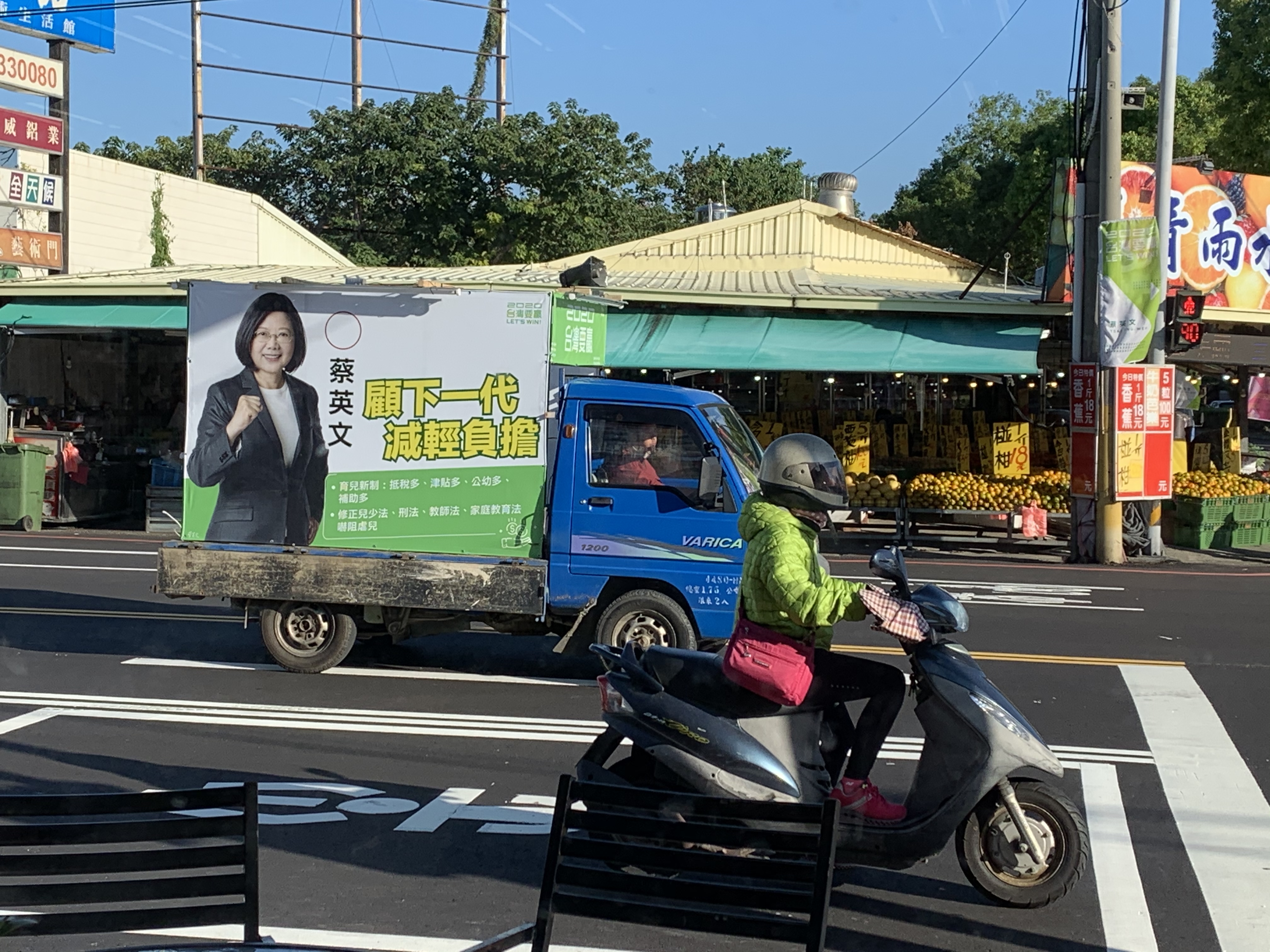
Since no other blogs are left that do this, I've decided to put up a few that I've collected this year. Although this isn't the most interesting one, I've decided to start with it because I didn't want the KMT to get the headlining photo. It's a typical noise truck on the outskirts of Miaoli, and says "Look to the next generation, alleviate [their] burden" - in line with Tsai's youth-vote focused campaign.

In Beitou (northern Taipei), we have Wang Zhi-bing (Zhibing meaning something like "Aspiring Ice" which is an interesting thing to be called).
Anyway, the poster and candidate are both noteworthy - look at the slogan. She deliberately uses ㄟ to represent 的, a way of showing that what you're writing is meant to be read in Taiwanese. That's rare for a KMT candidate unless they're trying to pander to a Taiwanese-speaking electorate (Ma Ying-jeou would occasionally deliver prepared speeches in Taiwanese, especially on 228, and he was terrible at it.)
You wouldn't think of Beitou necessarily as a Taiwanese-speaking area, but if you walk in the backstreets around Beitou MRT, you'll find that it actually is, at least to some extent. So this is probably a smart campaign move.
Because it could be Taiwanese and not Mandarin, I'm not sure if my translation is correct, but 尚好 means "best" or "first class" - the literal translation then is "first-class election". It's a positive message, and if you look Wang Zhibing up, you'll learn that she has a close friendship with at least one DPP legislator in her district, He Zhiwei, from their time as city councilors, and has even helped campaign for him. They both encouraged each other when they went to register for the legislative race.
Maybe I'm not reading enough into it, but I think that's nice. Maybe her use of Taiwanese is genuine!
Wang and her good buddy He Zhiwei are not running against each other, as they're in different legislative districts. Wang's DPP opponent is Wu Siyao.
That's related to the poster below, with the inspiring message, "I'm here!"

This is "unaffiliated" candidate Li Wanyu.
I don't really know what's up with her party-wise right now, and I thought she might be a pan-blue/unificationist/New Party type from the color of her sign, but no. She's formerly (and then again?) DPP, has close ties to Chen Shui-bian, and apparently joined the Taiwan Action Party Alliance (一邊一國黨, also known as TAPA) recently, a party closely associated with Chen.
No, I didn't know any of that off the top of my head. I looked her up.
Anyway, Li Wanyu has a...colorful personal history. Two incidents of public drunkenness in her past continue to haunt her image, and apparently the second time around she had to spend 20 days in jail after being convicted of hitting a police officer. There are other bits and bobs of personal gossip going around too, that I won't bother with because I don't care. Apparently in 2014 she was expelled from the DPP for voting for herself in some internal election, but was later allowed to re-enter the party.
So, Li is also running against Wu Siyao, which means she's also in the race against Wang Zhibing above (even though I am pretty certain I took these photos in two very different neighborhoods, I suppose the district is large-ish). There was a bit of a political kerfuffle recently when former president Chen went to a book signing with Li Wanyu, and seemed to be supporting her over DPP candidate Wu.
But then that's hardly surprising - Chen is TAPA, she's TAPA even though she's running as "unaffiliated" (at least that's what her poster says). Who would expect otherwise?
Ugh. So now we turn to...blatant slogan thieves!
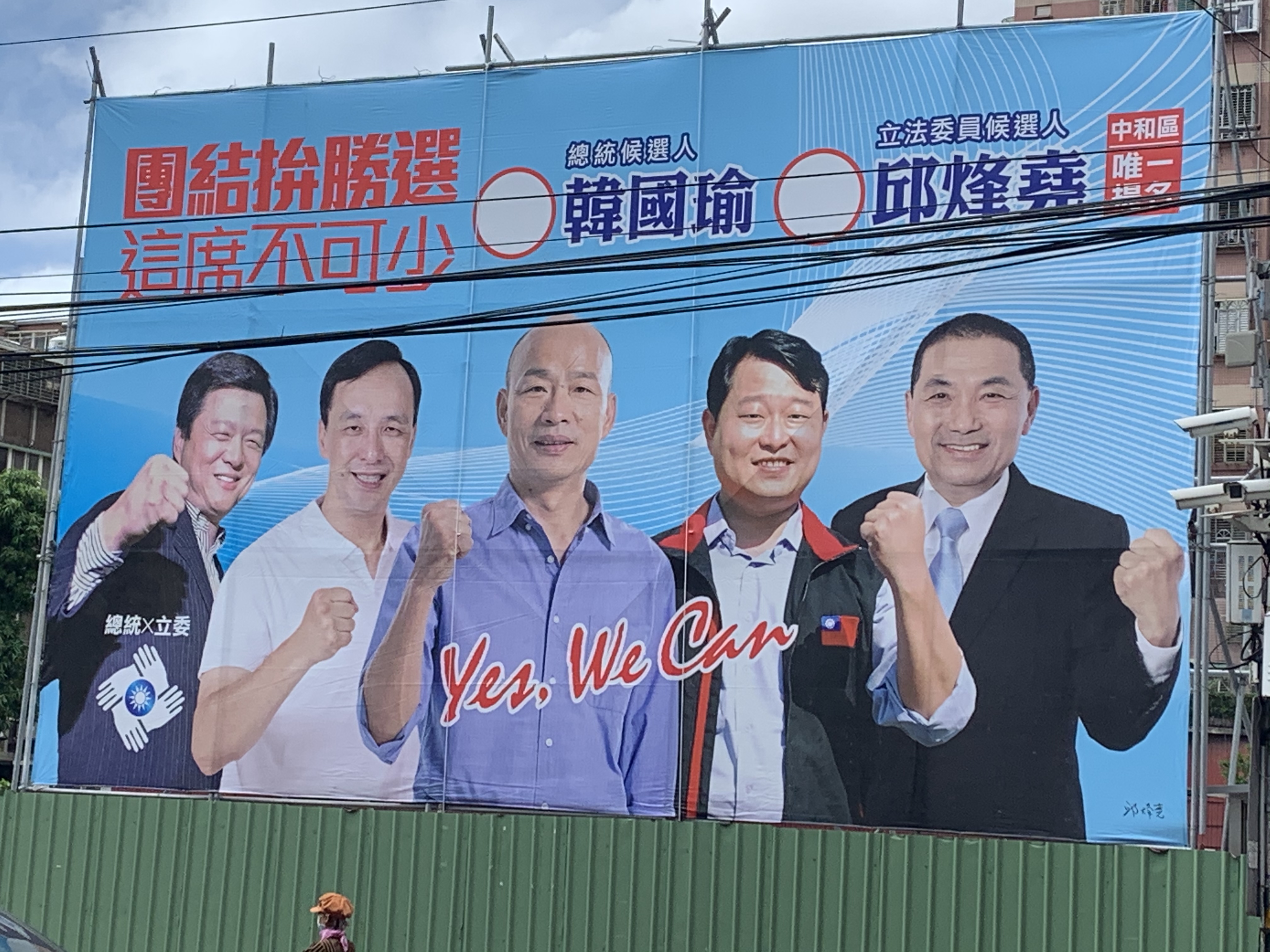
This poster in Zhonghe, near Burma Street, features Some Guy, Mr. Generic (that's former New Taipei mayor Eric Chu, which you may have forgotten because he's just that boring), Big Uncle Dirk, Poppin' Fresh (whom I think is actually the candidate here, Chiu Feng-yao, and yes, calling him Poppin' Fresh is super mean and uncalled-for but I'm not sorry), and Hou You-yi, the current New Taipei mayor, who seems to be genuinely kinda popular. Brendan's first comment is that they're positioned in such a way that they look like those Chinese god idols, when there's more than one on an altar.
It seems Chiu is already a city councilor who is now running for the legislature.
I noted that, although I don't like any of these guys, at least two people on this poster appear to be reasonably competent at their jobs. No, the current presidential candidate in the middle is not one of them.
Both of us noted that their slogan isn't exactly original, and isn't even current as of the 2010s. I do understand that English on these signs is often merely decorative and few people who can actually vote will bother to read it, even if they're able to (which, honestly, most people in greater Taipei are).
But still. Don't you even want to try?
Aaaaanyway, the slogan here is "Unite to win the election, this seat is indispensable". Which is about as exciting as Eric Chu.
I still can't figure out who the guy on the far left is. I know Chiu has campaigned with Lin De-fu, but unless that's heavily photohopped to make him look less like a grandpa and to have a full head of shiny hair, it ain't him.
Oh yeah, and I also pointed out when we were gazing in awe at how this poster manages to be terrible and boring at the same time, that they are all men. While I'm willing to criticize the DPP for not doing enough to promote female visibility in the party, it would be impossible for them to make a sign like this without at least one woman. That is - the president.
In other words, I think this poster could use some improvements.


Here's Wang Zhibing again, this time posing with Han Kuo-yu (ugh, maybe I don't think she's so okay after all) with a whole 'let's win the boxing match' theme going on. Cute.
Time for a palate-cleanser.
We're back at the DPP, this time with Da'an/Wenshan legislative candidate, Hsieh Pei-fen. Since Empty Suit Chiang Nai-hsin decided to retire (despite his campaign posters as recently as a few years ago still using photos of him in his 40s), this seat is up for grabs. KMT rising star and whiny tantrum-thrower Lin Yi-hua is running for the KMT, and the DPP is putting up Hsieh, who at age 32 - so the DPP really is trying to run a few younger candidates - has graduated from Harvard Law and NTU and worked in international affairs ever since, with an impressive string of credentials.
I'm not biased, of course.
She'll probably lose because this is Da'an, but it will give her exposure. I'm just pleased the DPP is bothering to run a real candidate. It shows they think this race is worth fighting for. The other guy is Wang Minsheng, a city councilor whose office is in that building.
Back to the KMT.

This vaguely interests me because it shows the KMT thinks Ma Ying-jeou still has star power, despite everyone hating him and even KMT voters heckling him at a Han rally. After learning the hard way what Taiwanese think about the 1992 Consensus, it's interesting as well that they give it such a prominent place on this poster, which has all the KMT symbolism just crammed in. We've got:
- Only men
- Many shades of blue
- Two prominent KMT "white sun on a blue sky" symbols, one on the ROC flag and the other on Han's Taiwanese Political Candidate/Taiwanese Grandpa vest (the DPP's fashion choices this year are way better, I have to say)
- The word "KMT" on two articles of clothing
- A reference to the 1992 consensus
- FISTS! (Except for Ma, who probably can't make a fist). Also, arm-crossing which I think they think is aggressive and business-y but just comes across as weird and defensive.
- A signal that they still think they are the party of a strong economy (as though we haven't figured out that, to the extent that's true - which it isn't really - it's because China helps them)
Also get a load of the "We Shall Return" logo on Ma's shirt. LOL.
The slogan here is "1992 Consensus, Fight for the economy". From trying to re-group after 2016 and perhaps rethink the way they approached voters, they seem to be trying to roar back into power by taking a hard right turn back to their old-school platforms.
The candidate here is Lai Shi-bao (Shih-pao? My Romanization is all over the place today), who seems to be trying to look younger with the hoodie and all. He's actually 68 years old, and very old-school KMT (minority leader in the legislature...and more. Basically super establishment).
Apparently this sign has appeared in more than one place, and there's a bit of a public debate going on about whether it's even a good idea to campaign on promoting the 1992 Consensus. Is it conspiracy-mongering tinfoil hattism to suggest that perhaps the CCP is directing the KMT to campaign this way - whether blatantly or tacitly - because it is just that tone-deaf?
In any case, apparently in another area where this poster appeared, DPP opponent Ruan Zhaoxiong put up a sign directly beneath it saying "the 1992 Consensus is One Country Two Systems" (a phrase which is even more unpopular in Taiwan).
Here's a campaign poster on a bus that also includes Ma Ying-jeou (who apparently can make a half-hearted fist).
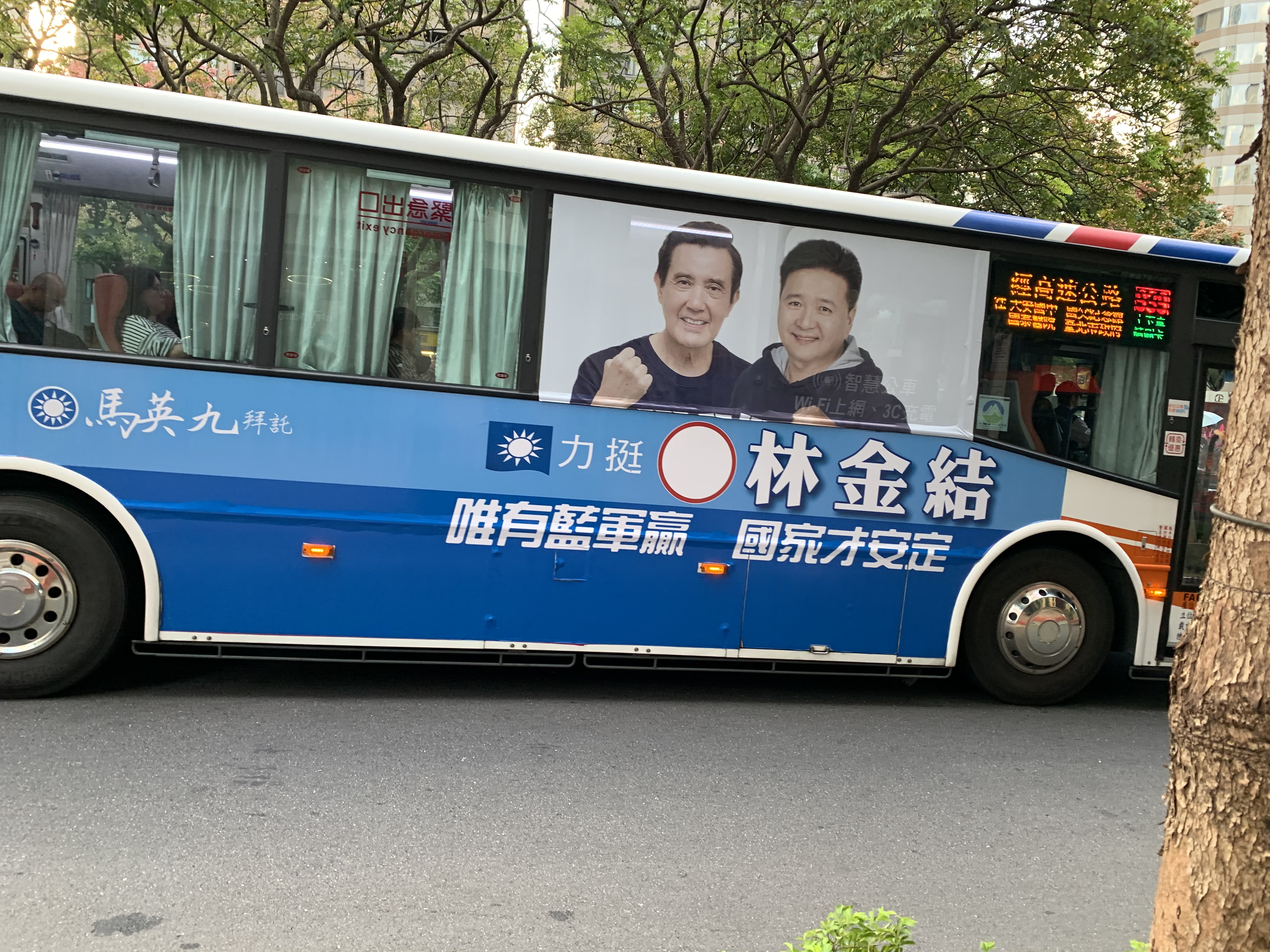
He's with Lin Jin-jie - and no, I'm not even bothering to try and standardize my Romanization. Lin is a candidate in New Taipei (Tucheng and Sanxia). He doesn't seem that interesting except that Terry Gou, who I suppose is a Big Man in the Tucheng area, where there is a big and rather ugly industrial park, and they don't seem to get along. Apparently people are not optimistic about his chances, and Gou has said "he won't be elected".
That photo is heavily photoshopped - the real Lin Jin-jie looks quite a bit older.
The slogan is "support the blue army to win, only then will the country have peace of mind" (it sounds better, though not less boring, in Mandarin).
The irony of that is staggering, seeing as it's the "blue army" that is routinely accused of working with China to undermine the country. Anyway, "an ding" (安定)is also a way of referring to a kind of sedative, though I suspect that usage is very rare. Somehow, "support the blue army to win, only then will the nation be heavily tranquilized" sounds more accurate, though.
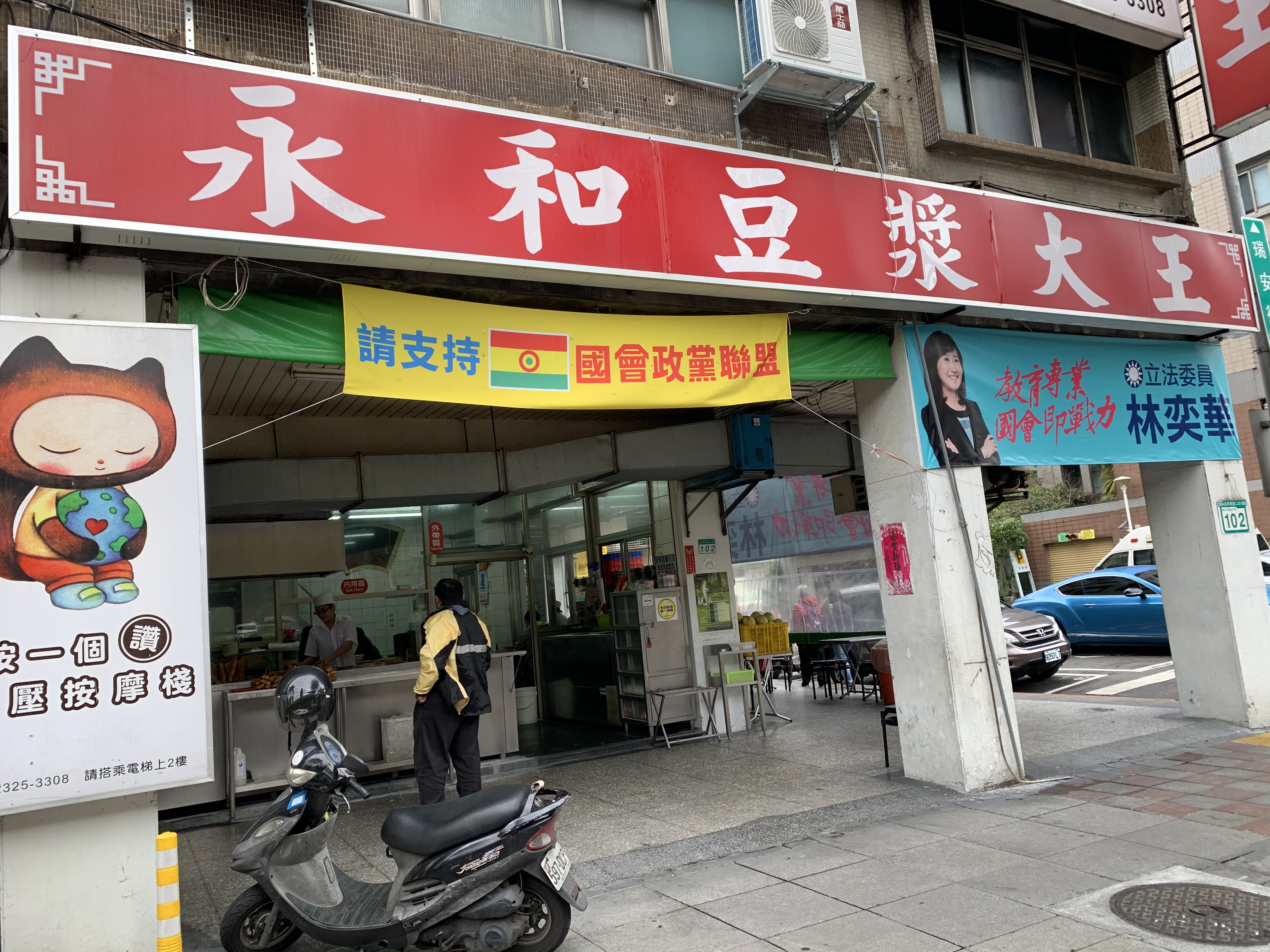
This is Lin Yi-hua - as with other politicians, photoshopped to look younger than she is - on a banner outside my favorite soy milk place on Fuxing Road. Lin is running against Hsieh Pei-fen in Da'an and Wenhua, and she pretends to be ill for political gain.
That's a shame; this Yonghe Soy Milk's breakfast grub (also, late night grub) is good and they're open 24 hours. The distance and the weird font mean I can't really read the slogan but it has to do with business and education - a platform-based sign. One could do worse.
Next to her, also put up by Yonghe Soy Milk, is a banner for the Congress Party Alliance (國會政黨聯盟). I don't know a lot about them except that they merged with the Minkuotang earlier this year. The Minkuotang has a weird religious component, is basically unificationist, and is pan-blue, so we can assume the Congress Party Alliance is too (apparently the chairman, Wujue Miaotian, is also a cultish religious figure and is the chairman of the newly-merged single party).
They strike me as creepy, and I'm not sure what's up with Yonghe Soy Milk in that they put up both a standard KMT banner (which I guess I can ignore) alongside the weird cult people banner.
This is a poster in a rural part of Miaoli Country for Chu Ying-hao, an unaffiliated candidate running against a KMT incumbent (Miaoli is super blue). I don't know if there's a DPP candidate campaigning as well, but they seem to be making a real effort to get whatever minority votes there are in Miaoli to come out for President Tsai, so maybe.
Nobody seems to know much about Chu, as he's a political newcomer. His main platform seems to be "more funding for Miaoli!" which will probably appeal to voters there - remember Miaoli is once the county that went broke thanks in part to simply not having enough money, but mostly due to previous financial mismanagement by the KMTers they keep electing for some reason.
(I think part of the reason is that Miaoli is heavily Hakka and Hakka voters tend to vote KMT, often though not always out of some deep-seated dislike for the old Hoklo chauvinism of the DPP, which many refuse to believe is waning. I'm not sure it matters, even, that Tsai is part Hakka.)

In fact, I spent the whole weekend in Miaoli and took as many campaign poster photos as I could.
At one point we got a little turned around up in the mountains and ended up in the small Indigenous village of Da'an. Candidates here campaign heavily on their Indigenous heritage - this poster above for Wu Li-hua references the "dreams of the Indigenous people" and the full autumn moon (not only is Mid-Autumn Festival important to Taiwanese with ancestry from China, but a fair number of Indigenous festivals take place around that time as well.)
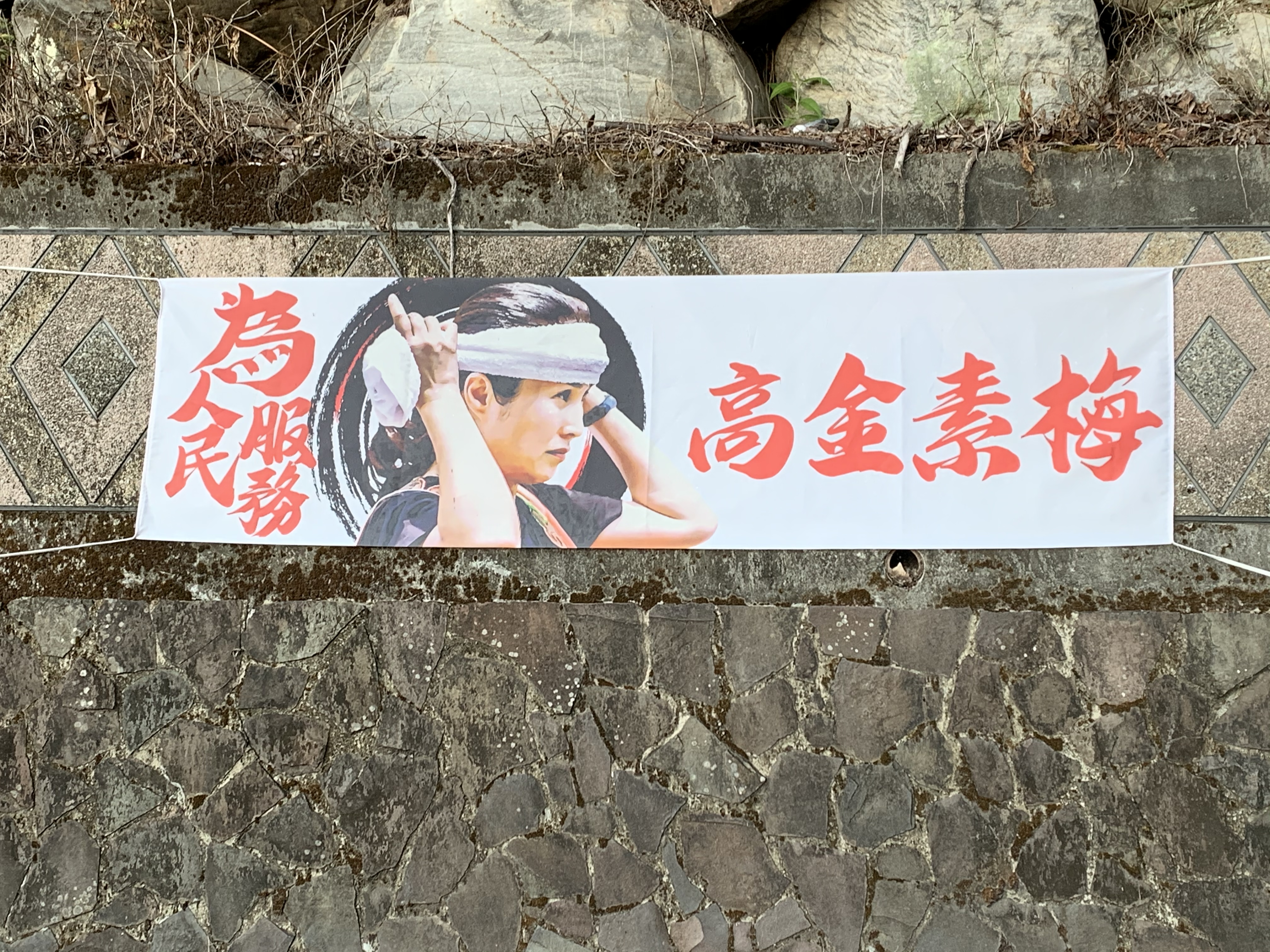
This one - with the ultra-boring slogan "To Serve The People" - is for May Chin (Gao Jin Su Mei or Ciwas Ali), a famous actress-cum-politician with Atayal (and Manchu) heritage. You may know her from Ang Lee's The Wedding Banquet. She's a member of the highly-partisan Non-Partisan Solidarity Union. On the good side, she's a strong advocate of Indigenous rights. On the other hand, she's also a unificationist.
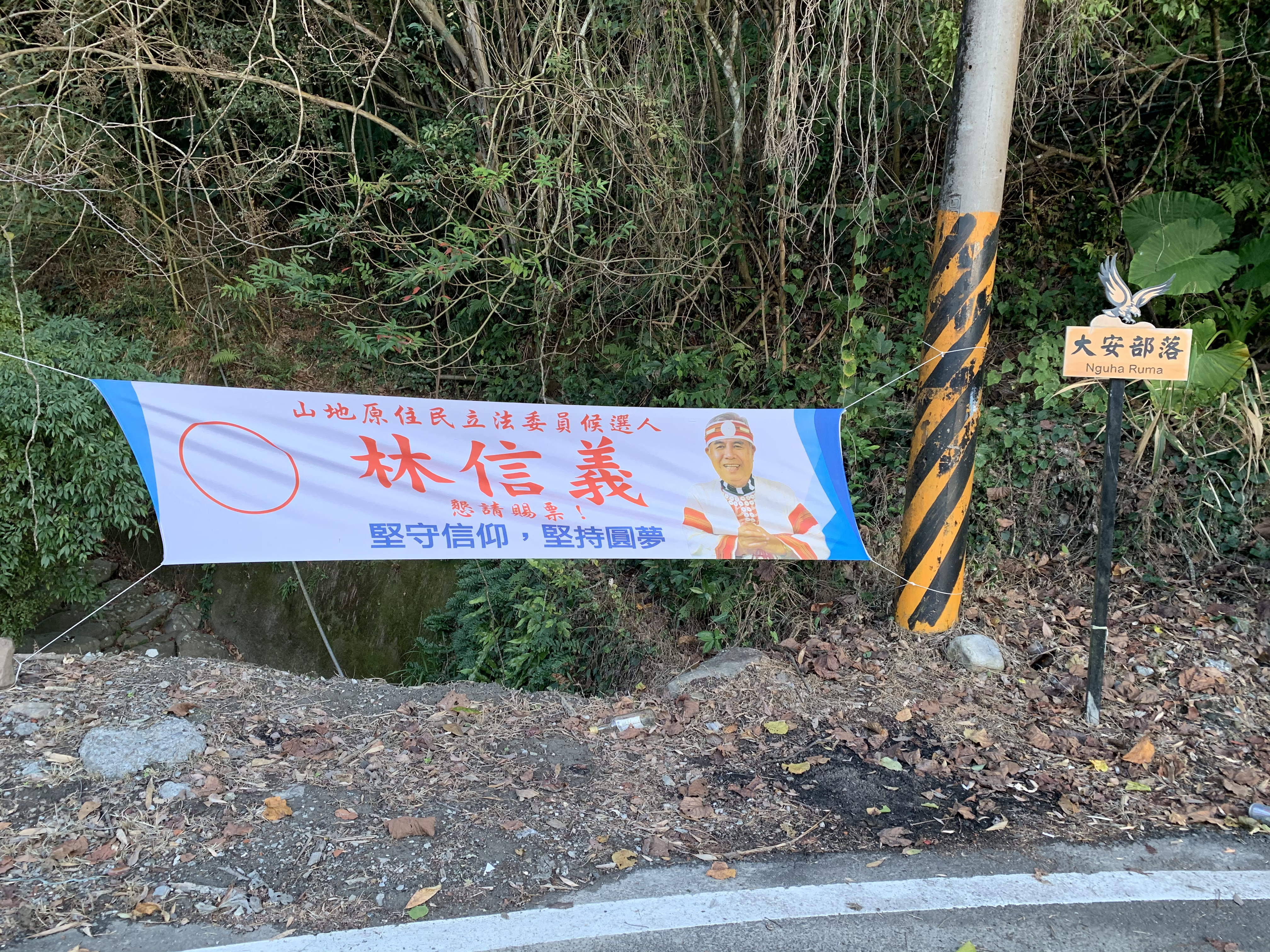
Running for re-election to the legislature is Lin Hsin-yi. No, not the former Vice Premier under Chen Shui-bian (I had to check too - in any case, the Indigenous population also tends to vote blue despite the KMT not caring one whit about them). This Lin Hsin-yi is not affiliated with a party and has criticized both the DPP and KMT sharply for not caring about Indigenous rights. I'm not sure why he's campaigning in Miaoli as he seems to be more closely associated with Fuxing township in Taoyuan, and at least used to be KMT? Not sure.
His slogan is "Hold fast to faith, hold fast to fulfilling your dreams". The first part is pretty standard, as Indigenous Taiwanese also tend to be Christian.
Anecdotally, I feel like even just ten years ago, it was common for whatever KMTer wanted to win to just show up and shake some hands in Indigenous areas, and then once elected proceed to do nothing at all for them. So it's interesting to me that now, it seems to win in an Indigenous area, Indigenous candidates lean heavily on their heritage.

There's not a lot to say about this absolutely huge and yet utterly boring poster for the DPP. The guy on the left is Luo Gui-xing (who is almost certainly Hakka - if you are a Luo from Miaoli, that's a dead giveaway). I can't see who the guy on the right is.
I can't find much about Mr. Luo, except that he was previously elected to the Miaoli County Council. Not sure how I feel about the square hair, though.
This is a good chance for me to opine on the DPP's slogan, however.
In Chinese, I like it. In English - yawn.
The Chinese is an adorable and lovely pun - "we want to win" sounds just like "We want Ying [the nickname of Tsai Ing-wen, who actively campaigns as 'Little Ying']". In English, "Let's Win" is pretty uninspired, though at least it's not stolen like 'Yes We Can'.
The good news is that I doubt Taiwanese voters care, even if they can read it. The blandness probably doesn't matter.
Then there's this guy:


Oh, Lin Yu-fang, how I hate you so.
I really hate this guy. He was defeated in 2016 by rock star and Sexy Legislator Freddy Lim, after a dirty and hateful campaign making fun of Freddy's hair (saying that men with long hair are 'abnormal') and putting up legitimately scary pro-death penalty posters near elementary schools, which said things like "Freddy Lim will let murderers walk free" (Freddy is against capital punishment, like a sensible sexy person.)
I know I don't have a leg to stand on being all indignant about making fun of Freddy's sexy, sexy hair, seeing as earlier in this post I called a guy Poppin' Fresh. But I'm still not sorry. Anyway, I'm a blogger, not someone working on campaign messaging.
Anyway, he might win his seat back, which sucks. Freddy's got a shot at re-election, but it seems at least one major temple in their very temple-heavy district - Qingshan Gong or the Green Mountain Temple - has decided to endorse Lin Yu-fang. I thought at first that allowing him to come pray at the head of the festival parade was just something the temple allowed candidates to do, but the two giant posters on either side of the temple point to more active support.
I can't read the first poster as the photo got cut off, but the second one has him posing in front of a little cartoon boring place. I think the message is, Make Wanhua Boring Again!
In truth, the message is "finish the MRT, push urban renewal". Seeing as the KMT's version of "urban renewal" is "tear down things that are interesting without giving adequate compensation to current residents, and build things that suck", I suspect Make Wanhua Boring Again is the more accurate phrase.
Gross.
Here's Sincere (and Sexy) Freddy Lim's noise truck rolling down Zhongxiao Road so you don't have to think about Lin Yu-fang anymore.

Though to be honest, they've sort of toned down the rocker look and hidden his hair for this campaign. He looks just like a normal guy here, but I am sure if re-elected he will once again morph into Sexy Legislator Freddy Lim.
In contrast to Lin Yu-fang's ads, which look like 1980s commercials for liver pills and real estate, Freddy's ad is bright, fresh and has clean lines and clear messaging.
Again, not that I'm biased or anything.




